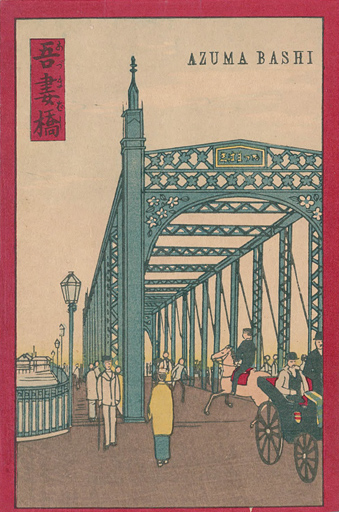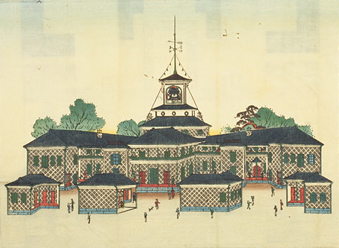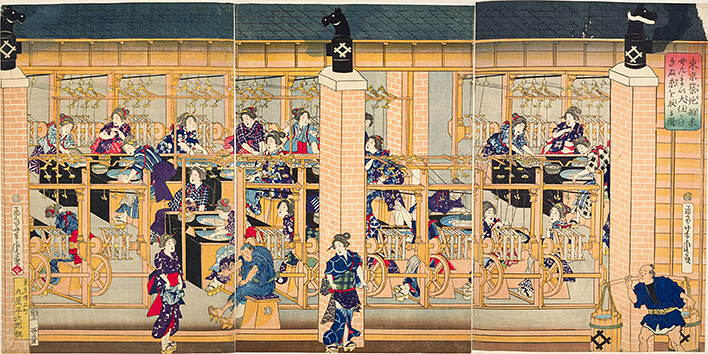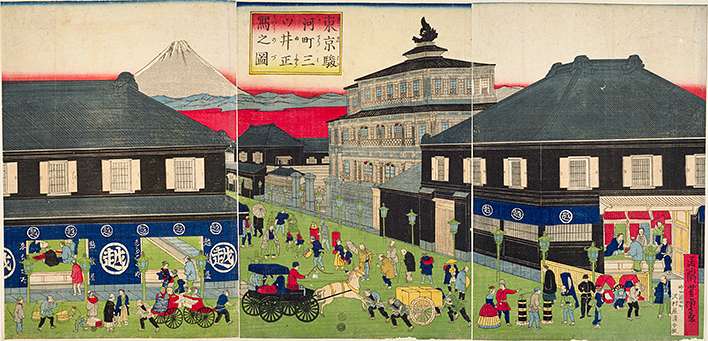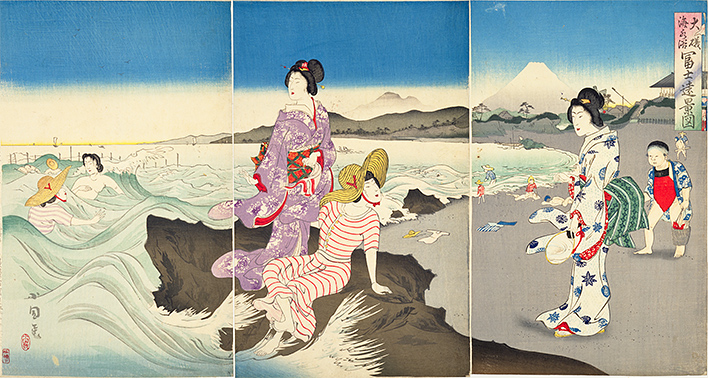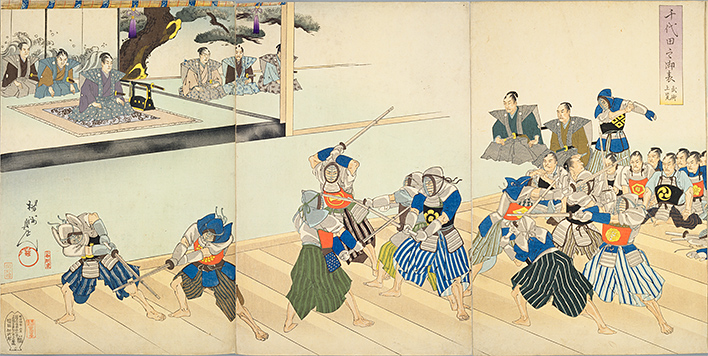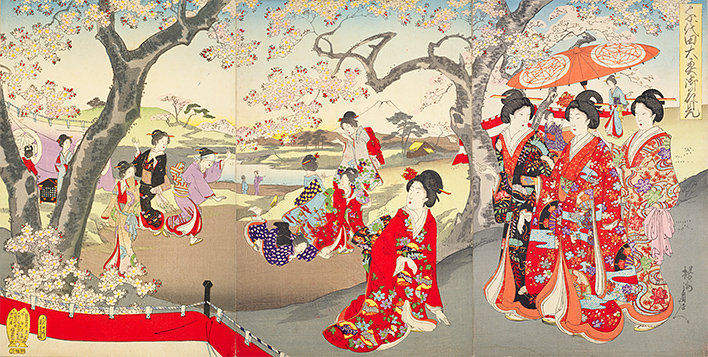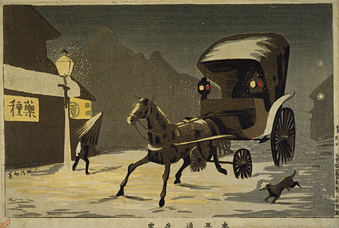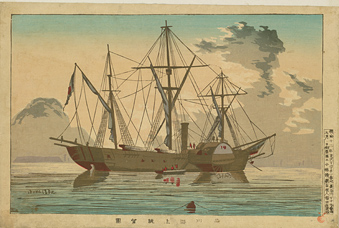Nishiki-e (brocade pictures) in the Meiji era
During the Edo Period, ukiyo-e (pictures of the floating world) were subject to censorship with regulation being applied mainly for the 3 reasons of criticism of the Shogunate, corruption of public morals or manners, and excessive extravagance, with punishments being applied for even the slightest suspicion of criticism of the government. In addition, the Tokugawa Shogunate and incidents and happenings involving the Shogunate from the same era were prohibited as subject matter for the images. The censorship was abolished in year 8 of the Meiji Era (1875), however in place of the aratame-in (censorship seal) it became required for the names and addresses of the creators and publishers to be specified instead.
Nishiki-e newspapers
Tokyo Nichinichi Shimbun no.101 ![]()
painted by Ochiai Yoshi'iku,
text by Tentendo head editor,
printed by Gusokuya
<Call no. : 本別7-522>
In the Meiji Era, ukiyo-e came to include journalistic elements which had been restricted in the past. Nishiki-e newspapers had illustrations of articles noted in the newspaper. Ukiyo-e artist Ochiai Yoshi'iku published the first Nishiki-e newspaper, the Tokyo Nichinichi Shimbun, in 1874. The content included many local news stories like scandals such as murders, incidents ending in bloodshed and scandals. In addition to Ochiai, other famous ukiyo-e artists of the time, such as Tsukioka Yoshitoshi and Toyohara Kunichika, also began to provide illustrations for newspaper companies.
Yokohama-e and kaika-e
Yokohama kenbutsu zue ijin osana asobi ![]()
by Issen Yoshikazu in 1860 <Call no. : 亥二-92>
When the port of Yokohama was opened in 1859 at the end of the Tokugawa Shogunate government, a variety of people and goods from within Japan and overseas began to gather in Yokohama, which had previously been a poor village, as it developed into a port town. This led to the birth of a specialized type of ukiyo-e called "Yokohama-e" which depicted the flourishing conditions of Yokohama and the lifestyles of the foreigners living there. (Right image)
Kaika-e pictures began to be produced which depicted the changes of the town as it underwent the process of Japan's Westernization movement during the Meiji Era. The images depict Japanese in western clothing and with western hairstyles, as well as western construction buildings based on the design and instruction of foreigners employed by the Japanese government, bridges replaced with stone and iron bridges, trains, horse drawn streetcars, steamships and other western transportation.
Ueno Park
Cherry blossom viewing
The women are carrying western umbrella and the men are wearing silk hats.
Tokyo meisyo no uchi Ueno koenchi oka sakari no kei ![]() by Hiroshige, printed by Noda Shigemasa in 1880 <Call no. : 寄別7-1-2-7>
by Hiroshige, printed by Noda Shigemasa in 1880 <Call no. : 寄別7-1-2-7>
Exhibition
In 1877, the First National Industrial Exhibition![]() was held. This is a nishiki-e that depicts the exhibition opening ceremony with the Emperor and Empress Meiji on the stage and the ambassadors from various countries in the front on the left.
was held. This is a nishiki-e that depicts the exhibition opening ceremony with the Emperor and Empress Meiji on the stage and the ambassadors from various countries in the front on the left.
Naikoku kangyo hakurankai kaijo goshiki no zu ![]() by Yoshu, Hashimoto, Naoyoshi, printed by Yamamoto Rihei in 1877 <Call no. : 寄別7-5-1-6>
by Yoshu, Hashimoto, Naoyoshi, printed by Yamamoto Rihei in 1877 <Call no. : 寄別7-5-1-6>
This image depicts the Third National Industrial Exhibition![]() . The site of the present Tokyo National Museum was the site of the exhibition. A steam locomotive can be seen to the right.
. The site of the present Tokyo National Museum was the site of the exhibition. A steam locomotive can be seen to the right.
Ueno ichiran naikoku hakurankai no zu ![]() by Kochoro Kunisada, printed by Fukuda Kumajiro in 1890 <Call no. : 寄別7-1-2-7>
by Kochoro Kunisada, printed by Fukuda Kumajiro in 1890 <Call no. : 寄別7-1-2-7>
Asakusa
Nakamise (the shops lining the passageway in the precincts of Buddhist temple) have become brick buildings.
Tokyo Asakusa kanzeon narabini koenchi rengaya shinchiku hanjo shinchi enkei no zu ![]()
by Eisai Shigekiyo, printed by Miura Bumei in 1886 <Call no. : 寄別7-5-1-4>
Railroad
The conditions of Shiodome Station. Among the people waiting for the steam locomotive, there are both those who are wearing western clothing and those wearing Japanese clothing.
Tokyo Shiodome tetsudokan jokisya machiai no zu ![]() by Rissai Hiroshige, printed by Iseya Kisaburo in 1873 <Call no. : 寄別7-1-2-6>
by Rissai Hiroshige, printed by Iseya Kisaburo in 1873 <Call no. : 寄別7-1-2-6>
Horse drawn carriages and bicycles
A variety of vehicles, including rickshaw, horse drawn carriages and bicycles, come and go across Nihon-bashi Bridge.
Tokyo Nihonbashi fukei ![]() by Utagawa Yoshitora, printed by Tsutaya Kichizo in 1870 <Call no. : 本別9-28>
by Utagawa Yoshitora, printed by Tsutaya Kichizo in 1870 <Call no. : 本別9-28>
Bridges
Ryogoku-bashi Bridge
In 1875, this bridge was replaced with a Western-style wooden bridge. In the image power lines can be seen in front of Mt. Fuji.
Tokyo godaikyo no hitotsu Ryogoku Shinkei ![]() by Kobayashi Kiyochika, printed by Matsui Seikichiiin 1876 <Call no. : 寄別7-2-2-4>
by Kobayashi Kiyochika, printed by Matsui Seikichiiin 1876 <Call no. : 寄別7-2-2-4>
Azuma-bashi Bridge
In 1887, this bridge was replaced with an iron bridge.
Azuma Bashi (Tokyo Meishocho) ![]()
by Inoue Tankei, printed by Fukuda Kumajiro in 1887 <Callno. : 寄別7-9-2-1>
Western-style architecture
Tsukiji Hotel. Opened in 1868, this was the first full-fledged Western-style hotel in Japan.
Toto Tsukiji hoterukan no zu ![]() printed by Shaisho in 1868 <Call no. : 寄別6-3-4-5>
printed by Shaisho in 1868 <Call no. : 寄別6-3-4-5>
Factories
The Ono-gumi Tsukiji yarn making factory. This was an Italian-type yarn making factory which began operation in 1871.
Tokyo Tsukiji hakurai zenmai oojikake kinuito o toru zu ![]() by Mosai Yoshitora, printed by Maruya Heijiro in 1872 <Call no. : 寄別7-3-1-4>
by Mosai Yoshitora, printed by Maruya Heijiro in 1872 <Call no. : 寄別7-3-1-4>
Banks
The western-style building of the exchange bank Mitsui-gumi (present day Mitsui Bank) constructed by the Shimizu-gumi (present day Shimizu Corporation) in Surugacho (present day Chuo-ku Muromachi) in 1874.
Tokei Surugacho Mitsui shoutsushi no zu ![]() by Mosai Yoshitora, printed by Sawamuraya Seikichi in 1874 <Call no. : 寄別7-3-1-4>
by Mosai Yoshitora, printed by Sawamuraya Seikichi in 1874 <Call no. : 寄別7-3-1-4>
Sea bathing
Women enjoying sea bathing. Some of the women pictured are wearing bathing suits.
Oiso kaisuiyoku Fuji enkei no zu ![]() by Kokunimasa, printed by Katada Chojiro in 1893(Fuzoku nishiki-e zaccho <Call no. : 寄別2-9-2-1>
by Kokunimasa, printed by Katada Chojiro in 1893(Fuzoku nishiki-e zaccho <Call no. : 寄別2-9-2-1>
Inside of the Edo Castle
Though previously prohibited during the Edo Period, the conditions inside of Edo Castle also came to be depicted. The Chiyoda no On'omote ![]() and Chiyoda no Ooku
and Chiyoda no Ooku ![]() nishiki-e from a series by Yoshu Chikanobu provide a glimpse at the daily lives and yearly events of the Shogun and his inner court.
nishiki-e from a series by Yoshu Chikanobu provide a glimpse at the daily lives and yearly events of the Shogun and his inner court.
Martial arts training being carried out before the Shogun.
Chiyoda no On'omote Bujutsu joran ![]() By Yoshu Chikanobu, printed by Fukuda Hatsujiro in 1897 <Call no. : 寄別8-5-2-1>
By Yoshu Chikanobu, printed by Fukuda Hatsujiro in 1897 <Call no. : 寄別8-5-2-1>
Cherry blossom viewing inside the grounds of Edo Castle.
Chiyoda no Ooku Ohanami ![]() by Yoshu Chikanobu, printed by Gusokuya and Fukuda Kumajiro, in 1894 <Call. No : 寄別8-5-2-1>
by Yoshu Chikanobu, printed by Gusokuya and Fukuda Kumajiro, in 1894 <Call. No : 寄別8-5-2-1>
Kosenga
Among the nishiki-e painted in the Meiji Era were a type called "Kosenga". Kosenga are ukiyo-e which use perspective, shadow and chiaroscuro techniques from western art to express light, started by Kobayashi Kiyochika in 1876 and were said to have been named by the publisher Matsuki Heikichi. Kobayashi Kiyochika learned photography from Shimo'oka Renjo, Western art techniques from Wirgman and traditional Japanese painting from Kawanabe Kyosai and Shibata Zesin and unified all of these techniques to create Kosenga. Kiyochika stopped painting Kosenga in 1881, however his pupil Inoue Yasuji continued painting them until his death in 1889.
Honmachidori yasetsu ![]()
by Kobayashi Kiyochika,
printed by Fukuda Kumajiro
<Call no. : 寄別2-1-2-5>
Shinagawa kaijo Chobo no zu ![]()
By Kobayashi Kiyochika,
printed by Fukuda Kumajiro in 1879
<Call no. : 寄別1-9-2-3>
Aka-e (woodblock prints using imported aniline dyes, "red pictures")
As seen up until this point, one of the characteristics of the nishiki-e from the Meiji Era is the vivid reds. At the end of the Edo Period, the man-made pigments such as bero-ai (Berlin blue), aniline (red) and ramco (purple) were imported and widely used due to their low cost and great color production. These imported pigments led to sharper tones in ukiyo-e. In particular, the almost glaring red and purple came to be very noticeable during the Meiji Era, and because red colors which used aniline pigment in particular stood out, these pictures came to be generally called "Aka-e". Whether because of these garish colors or not, the nishiki-e from the early Meiji Era are not as popular today. However, according to Higuchi Hiroshi in the Bakumatsu Meiji Kaikaki no Nishikie Hanga, these new colors truly symbolized the Meiji Era which he described as, "The shades between these glaring red, blue and purple base colors show the growth of the Meiji Era and are truly indicative of the products of this age of growth."
The decline of nishiki-e
From the beginning of the Meiji Era until around year 20 of the Meiji Era, Western printing technologies such as letterpresses and lithography were introduced and put to use in Japan, allowing for mass printing. In 1870, the Yokohama Shimbun newspaper began to be published as a daily newspaper using letterpress printing. From around 1881, lithography became the standard, reaching its height in 1889. In addition, in the same year, Ogawa Kazuma opened a platemaking factory using the collotype he had learned in America, and Hoshino Shaku introduced artotype (the same as collotype) to Japan. In 1890 a platemaking method for photography zinc plates was commercialized by Hori Kenkichi, making possible the printing of photographs.
Nishiki-e were inferior to printing in terms of publishing speed, realism and price, and gradually fell into decline. Sales of wartime nishiki-e were good during the Sino-Japanese War which started in 1894 and it seemed as if they had regained their popularity. However, during the Russo-Japanese War 904-1905, the ability to carry out mass color printing through tri color separation and planographs, as well as the massive sales of war memorial picture postcards issued by the Department of Communication led to an extreme flow of picture postcards, so nishiki-e did not gain much popularity.
An article in the Asahi Shimbun newspaper in 1907 stated, "one of the famous products of Edo, nishiki-e have in recent years become a shadow of their former popularity and declined, (abridged) as photography techniques gain popularity, with picture postcards being in fashion in recent years, especially those produced with collotype, and nishiki-e portraits are not to be found with no artists to paint them and therefore no engravers to carve them.", (October 4, morning edition), showing that by this time, nishiki-e had almost completely ceased to be produced.
Bibliography
- Censorship, Media, and Literaty Culture in Japan, edited by Suzuki Tomi, et al., Shinyosha, 2012 <Call no. : UM71-J5>
- Nonogami Kei'ichi, Bunmei kaika fuzoku zukushi : yokohama-e to kaika-e, Iwasaki bijutsusha, 1978 <Call no. : KC16-713>
- Bakubatsu Meiji kaikaki no nishiki-e hanga, edited by Higuchi Hiroshi, Mito Sho'oku , 1943 <Call no. : 733-H448b>
- Takatsu Takashi ; Niwa Kenji, Meiji no ukiyoeshi to Seinan senso, Kagoshima University Library, 2011 <Call no. : Y121-J6383>











